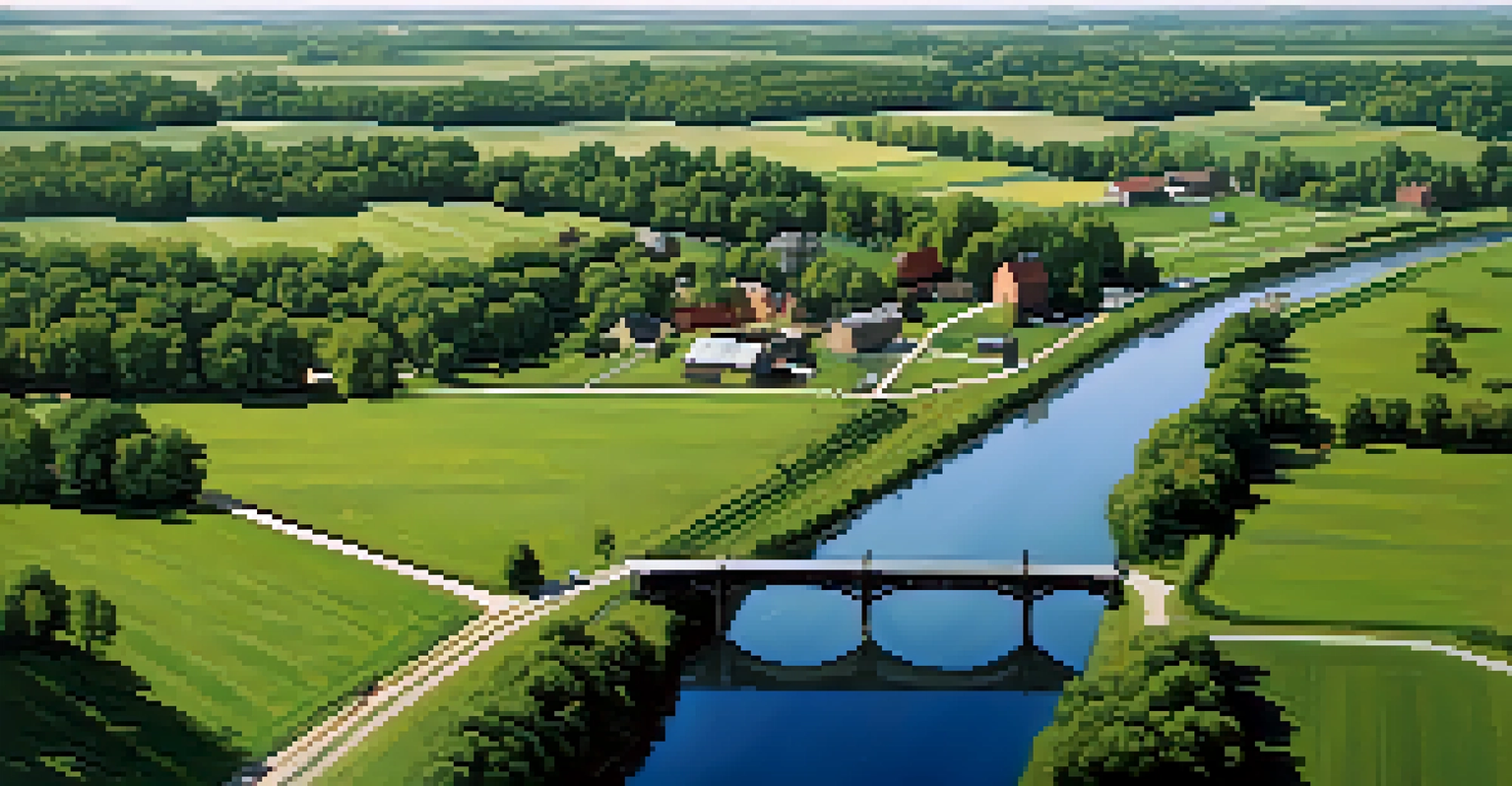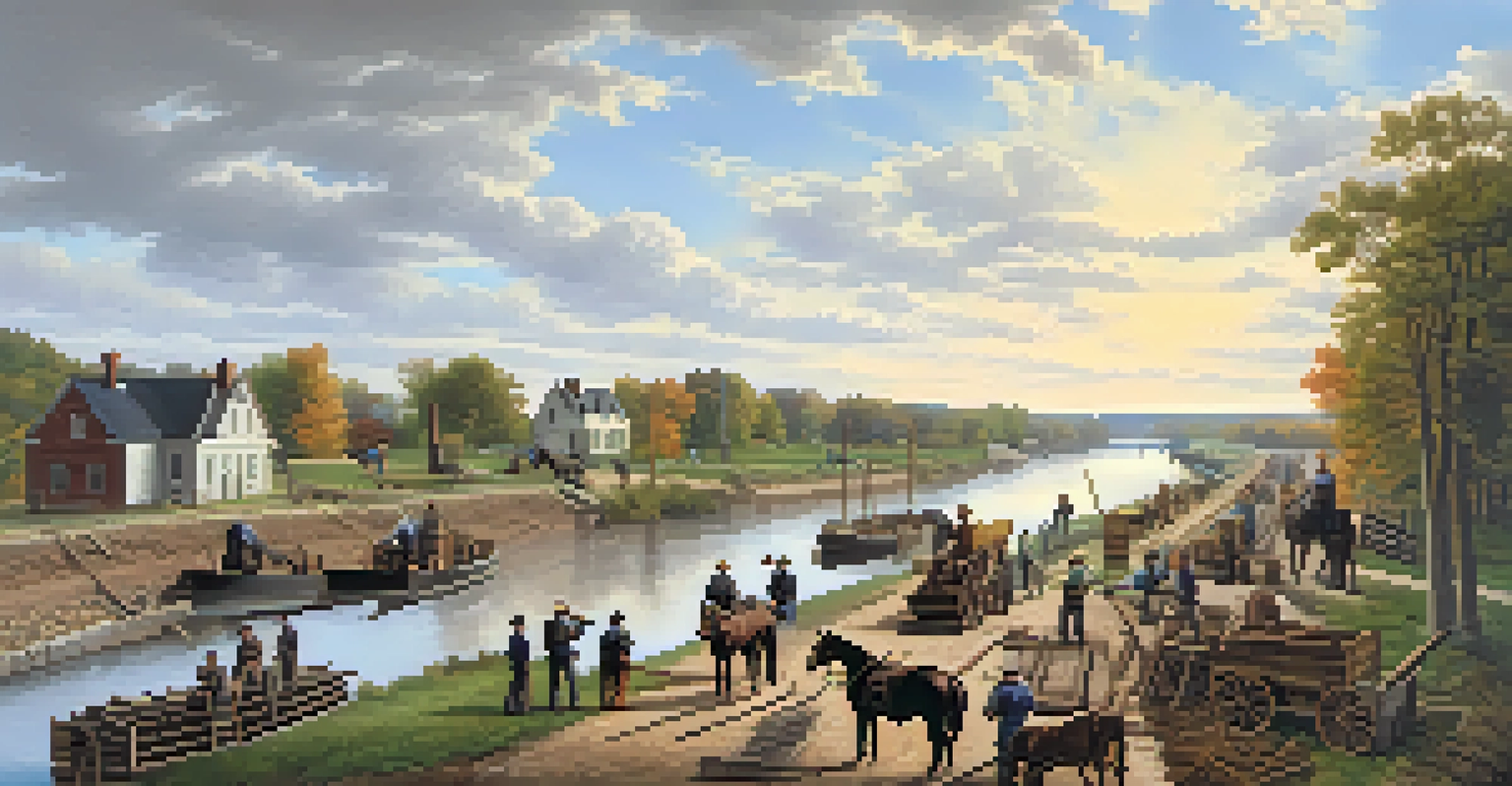The Erie Canal: A Transformative Project in NY History

Introduction to the Erie Canal's Historical Significance
The Erie Canal, completed in 1825, is a monumental engineering feat that transformed New York State and beyond. This 363-mile-long waterway connected the Hudson River to Lake Erie, facilitating trade and travel. The canal's construction marked a pivotal moment in American history, symbolizing innovation and ambition during the early 19th century.
The Erie Canal is one of the great engineering achievements of the 19th century, and it transformed the economy and culture of New York State and the nation.
Before the canal, transporting goods across New York was cumbersome and expensive, often requiring long overland journeys. The Erie Canal changed the game by drastically reducing transportation costs and times, making it easier for farmers and merchants to reach markets. This newfound accessibility helped propel New York City into a position of economic dominance.
The canal wasn't just a transportation marvel; it also fostered a sense of community and collaboration. People from diverse backgrounds came together to work on the project, showcasing the spirit of unity that characterized this ambitious endeavor. The Erie Canal became a vital artery for the state, influencing its growth and development for generations.
The Engineering Challenges and Innovations
Building the Erie Canal was no small task; it required overcoming numerous engineering challenges. Workers had to navigate through various terrains, including mountains and swamps, which necessitated innovative solutions. One notable technique was the use of lock systems, which allowed boats to navigate changes in elevation along the canal's route.

The project called for advanced construction methods and materials, setting a new standard for engineering at the time. Workers used limestone, clay, and timber, often employing local resources to minimize costs. This approach not only benefitted the project but also spurred economic activity in surrounding communities.
Erie Canal Transformed Trade
The Erie Canal revolutionized trade by connecting the Atlantic Ocean to the Great Lakes, significantly reducing transportation costs and times.
Despite facing opposition and financial hurdles, the dedication to innovation prevailed. The successful completion of the Erie Canal demonstrated the power of human ingenuity and perseverance. It paved the way for future infrastructure projects, showcasing the importance of adaptability in engineering.
Economic Impact: Boosting Trade and Commerce
The Erie Canal had a dramatic economic impact, transforming New York into a bustling commercial hub. By connecting the Atlantic Ocean to the Great Lakes, it opened up new markets for farmers and manufacturers. This enhanced trade flow led to a significant decrease in the cost of goods, benefiting consumers and boosting local economies.
As the Erie Canal opened the West, it also opened the hearts of Americans to the idea of progress and the power of infrastructure.
With the canal in place, agricultural products from the Midwest could move more freely to the East Coast, while manufactured goods traveled westward. This exchange of resources contributed to the growth of cities, particularly New York City, which became a vital port. The canal effectively reshaped economic landscapes, leading to increased prosperity for many.
Moreover, the canal spurred the development of industries along its banks, from shipbuilding to tourism. Towns flourished as businesses emerged to cater to the influx of travelers and traders. The sustained economic growth initiated by the Erie Canal had lasting effects, paving the way for the industrial revolution in America.
Social Changes: Migration and Settlement Patterns
The Erie Canal influenced not just the economy but also social dynamics across New York State. Its construction and subsequent operational success attracted a wave of migration, with people seeking new opportunities. Immigrants, particularly from Europe, flocked to the canal's route, drawn by the promise of work and prosperity.
As communities grew around the canal, new cultural and social identities emerged. The influx of diverse populations enriched local traditions, leading to a vibrant tapestry of cultures. Festivals, markets, and social gatherings became commonplace, fostering a sense of belonging among residents.
Cultural Impact and Community
The canal fostered a vibrant cultural exchange and community growth as diverse populations migrated along its route in search of opportunities.
Additionally, the canal played a crucial role in the westward expansion of the United States. It facilitated the movement of settlers into the Midwest, making it easier to establish new farms and towns. The social changes initiated by the Erie Canal created a ripple effect that would shape the nation for years to come.
Environmental Considerations and Challenges
While the Erie Canal brought about significant advancements, it also raised environmental concerns that still resonate today. The construction process altered natural landscapes, impacting local ecosystems and wildlife habitats. The introduction of the canal changed water flow patterns, affecting the delicate balance of the surrounding environment.
Moreover, the increased traffic on the canal contributed to pollution, as boats and cargo often released waste into the water. This environmental impact highlighted the need for balance between progress and preservation. Over time, awareness of these issues has led to initiatives aimed at restoring and protecting the canal's ecosystems.
Today, efforts are underway to address these environmental challenges while honoring the canal's historical significance. Restoration projects aim to revitalize the waterway and its surroundings, ensuring it remains a valuable resource for future generations. The Erie Canal stands as a reminder of the importance of sustainable development in our pursuit of progress.
Cultural Legacy: The Erie Canal in Arts and Literature
The Erie Canal's impact extends beyond economics and engineering; it has also left a profound cultural legacy. The canal inspired countless works of art, literature, and music, reflecting its importance in American identity. One famous song, 'Low Bridge, Everybody Down,' captures the essence of life along the canal and the hard work of those who navigated it.
Artists and writers have drawn inspiration from the canal's scenic beauty and historical significance. The picturesque landscapes and bustling towns along the waterway serve as a backdrop for stories of adventure, hardship, and community. This cultural heritage continues to be celebrated through festivals and events that honor the canal's history.
Environmental Challenges Persist
The construction and use of the Erie Canal raised environmental concerns that continue to influence restoration and preservation efforts today.
Moreover, the Erie Canal has become a symbol of progress and innovation in American culture. Its story resonates with themes of determination and collaboration, inspiring future generations to pursue their dreams. The canal's legacy is a testament to the enduring spirit of those who built it and the communities that flourished because of it.
Modern-Day Relevance and Preservation Efforts
In today's world, the Erie Canal remains a vital part of New York's heritage and identity. Preservation efforts are essential to maintaining the canal's integrity and ensuring its historical significance is not forgotten. Organizations and local governments work together to promote the canal as a recreational and educational resource for residents and visitors alike.
The canal has been repurposed for modern uses, such as boating, hiking, and cycling. It serves as a picturesque destination for outdoor enthusiasts seeking to explore its scenic pathways. By embracing its historical roots while adapting to contemporary needs, the canal continues to thrive as a cherished landmark.

Additionally, educational programs and events highlight the canal's history and its role in shaping New York. Schools and communities collaborate to host activities that engage people of all ages, fostering a sense of pride and connection to this historical treasure. The Erie Canal's relevance endures, reminding us of the importance of preserving our past for future generations.